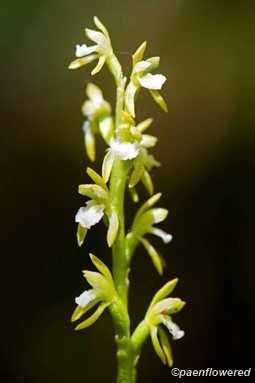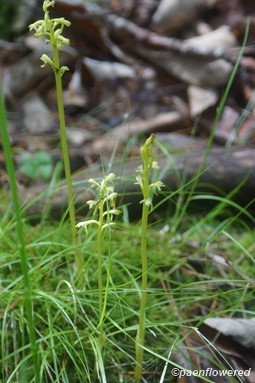Corallorhiza trifida
Corallorhiza trifida early coralroot
Coralroots are perennial members of the orchid family that lack green pigment and bear their flowers on a leafless stalk. Although the buds are red, the individual mature flowers are light brownish-green to yellowish-white. Flowers are 0.2 inches long and are made of seven tepals (petals and sepals that look similar in form and color). There are distinct upper and lower lips. The fruit is a capsule that ripens from green to brown. The seeds are tiny and numerous. Several scales (modified leaves) are pressed closely to the stem.
They get their nourishment from organic material absorbed by the coral-like many-branched underground stem. It has no roots but obtains food through a symbiotic relationship with soil fungi. The northern or early coralroot orchid flowers usually have no spots, distinguishing it from the related spotted coralroot (C. maculata). It blooms early in the spring, usually May and June, so look for this one after the snow melts. Its range is in Canada, the northern United States as far south as Maryland and throughout the West. In Pennsylvania it is historically documented in the counties near Lake Erie and in the Laurel Mountains. They are considered an endangered species in Ohio, Maryland and Indiana. It is a circumpolar species and occurs throughout Europe and northern Asia. They grow in swamps, moist boggy forests, bogs, and along stream stream banks and ditches. It is seldom seen because of its small size, unspectacular appearance and the dim lighting of its habitat. Another common name for this species is yellow coralroot because the roots are yellowish-white in color. Two other unrelated non-photosynthetic flowering plants are pine sap and Indian pipe. The species grows 4-10 inches tall.
Habitat & Range
Grows in bogs, swamps, boggy forests, and along stream banks.
Scattered populations throughout the state.
| EMP: | FACW |
|---|---|
| NCNE: | FACW |
Phenology
Flowers May to July.
Plant Codes
S-rank: S4 (Apparently secure)
G-rank: G5 (Secure)





Comments
Have you spotted this plant in your area? We'd love to hear about your experience! Share your comments or questions about the plant below. Comments are moderated before posting.